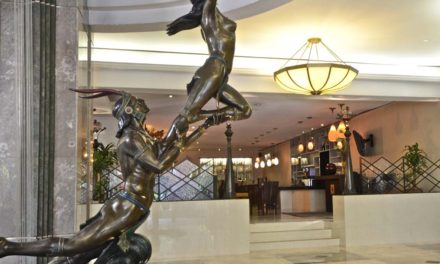Tuesday 11 June 2013
The Mayor of London, Boris Johnson has outlined his agenda to secure London’s future as the best big city in the world as he presented his vision for the capital’s growth as a key driver of the UK economy at City Hall today.

To mark the publication of his ‘2020 Vision – The Greatest City on Earth; Ambitions for London’ the Mayor addressed an audience of business leaders, government representatives and key London employers on the challenges facing the capital, not least that London’s population will hit ten million by 2030. London also needs 400,000 new homes in the next ten years alone.
Advocating the need for stable and continuous investment in housing and infrastructure projects in particular, the Mayor highlighted that the capital now contributes a greater share to the UK’s economic output than any point in its history and its future prosperity, and that of the whole country, is reliant on hardworking Londoners.
Delivering a message that to truly prosper all those with a vested interest in London’s future, must recognise the size of the task, agree a goal and forge a shared path to success, the Mayor made it clear that Londoners need jobs and homes – and a quick and convenient way of getting from one to the other. He continued that our children should be well educated and that young adults must have the chance to develop the skills and confidence to get jobs in the creative, tech, finance, construction, hospitality and service industries in which London excels.
Highlighting emerging opportunity areas across London, including Battersea, the Royal Docks, Greenwich, Tottenham, and Croydon, amongst others, the Mayor talked of the need to invest in Crossrail Two, together with new tube extensions and river crossings.
Outlining his aspirations for the capital and its residents, the Mayor talked of a future where the delivery of public health improves and there is a steady improvement in academic achievement for Londoners. He also talked of his desire that people continue to flock to the capital to study, start their careers and get a foot on the property ladder, but that they stay to bring up their families and start their businesses here without feeling the need to relocate elsewhere.
The Mayor of London Boris Johnson said: “Post-Olympic London has an amazing story to tell of a city that is leading the UK out of recession as the best place to work, live, play, study, invest and do business, and my goal is to lengthen London’s lead as the greatest city on earth. In the summer of 2012 this city put on a triumphant performance, showing us exactly what we can do if we focus and plan, and agree on the challenges facing our city, and today is my personal view of how we can work together to meet those challenges.
“To succeed we must recognise the test of our mettle that lies ahead, not least a million more people in the next decade and a vast shortage of homes in an uncompromising global economy. This shows us why the government must invest in London’s future for the good of the whole of the UK and exactly why we must continue to attract international investment. I want this vision to be one which sparks the imagination of every Londoner as well as business leaders and government officials. This is everyone’s city and all of our futures.”
Mayor Jules Pipe, Chair of London Councils, said: “This is both a very exciting and challenging period in London’s history. I welcome this timely piece of work from the Mayor, particularly highlighting the value of partnership to address shared issues around housing, health and regeneration.”
Colin Stanbridge, Chief Executive of the London Chamber of Commerce and Industry (LCCI), said: “The on-going success story of London as a unique and world class city could lead many to take the capital’s future growth potential for granted but now is not the time for complacency. We welcome this report which both recognises London’s current predominance, demonstrated in particular by the events of 2012, and sets out a vision for how the capital can excel even further in the future.
“The Mayor has certainly listened to the business community in committing to delivery of projects like Crossrail 2 and new river crossings in east London, however, these projects will be at risk if the Chancellor cuts TfL’s funding in the upcoming spending review. We expect the Mayor to vigorously lobby ministers to secure the best long term funding deal for London.”
Grant Hearn, Travelodge Chief Executive and Member of London Enterprise Panel, said:
“Through this vision companies like Travelodge can continue to create jobs and offer people great careers. It allows us to continue making entry-level jobs available to the long-term unemployed thanks to our pioneering partnership with Job Centre Plus, and it means we can still provide opportunities for young people. This is critical in today’s climate where going to University is not affordable for everyone and jobs can be so difficult to find.
“London is the powerhouse of the UK economy, and 46% of all tourism that comes to the UK goes through the capital at some point. Whatever can be done to make London even more attractive as a destination not only helps the capital, but the rest of the UK too. The 2020 Vision capitalises on that and puts London on a very bright path indeed.”
Joanna Shields, Chief Executive of Tech City and UK Business Ambassador for Digital Industries said: “Through a bold vision, London’s combination of creativity, entrepreneurship and investment opportunities has secured our position as Europe’s digital capital. Digital skills are the currency of the future and increasing the numbers of apprenticeships and workplace opportunities are vital to our continued growth. We look forward to working with the Mayor to boost digital skills, establish entrepreneurship as a credible career path and make London the best place to imagine, start and grow a business.”
www.london.gov.uk/london2020vision.com
Notes to Editors
For more information and to read the Mayor’s 2020 Vision please visit: www.london.gov.uk/london2020vision
School places – p.19
• In 2012 there were 15,000 London kids who left primary school, age 11, still struggling with basic English and Maths.
• There were 28,000 who left school at 16 without the five decent grades at GCSE that are considered essential for a good start in life.
• The Mayor is making a series of targeted interventions to help young Londoners through his ‘Literacy Champions’ to help 3-5yr olds with their reading; mentoring programmes, Leadership clubs, Latin clubs, a Music Fund to help address that only 8% of pupils at maintained sector secondary schools have access to a musical instrument. Plus the School’s Excellence Fund to promote and encourage good teaching in the core academic subjects.
Apprenticeships –p.23
• In the last two and a half years, London has created about 100,000 such apprenticeships, and we have set a target of 250,000 by the end of the academic year 2016 – we will not only make a dent in youth unemployment; we will provide London’s businesses with employees that they values, that they overwhelmingly retain and that add to the bottom line.
Transport p.25
• By 2018 we will have completed Crossrail, with 24 trains per hour carrying 200,000 people across London from east to west, hooking up Heathrow with Stratford and the opportunity areas of east London. We are now well advanced in a massive programme of upgrading the tube – to increase capacity by 33% by 2018. The Jubilee and Victoria lines have already been significantly improved; the Northern line will be complete by 2014 – delivering a 20 per cent increase in capacity, and we must urgently begin work on renewing the Central, Piccadilly and Bakerloo lines.
• P.28 Crossrail- In Southall and Ealing, developments are now under way that will see another 4,000 homes and perhaps 2,000 jobs – and all made possible because of Crossrail stations.
• P.53 When Crossrail is complete, Stratford will be just about the best connected transport hub in the UK. There will be nearly 8,000 homes – good quality homes, many of them for families – fringed around the biggest new green park in Britain for 150 years. The objective is to transform the area into a place families aspire to live in, a destination; and that is what we are already achieving with the Olympic and post-Olympic programme.
Opportunity areas p.28
• Opportunity areas around London: where there is scope to build 100s of thousands of homes on brownfield sites- transport links decisive in allowing development to progress.
• At Old Oak Common there is scope to create a whole new district – a mini-city – with 22,000 homes and 50,000 jobs, and again, all because of the Crossrail stations and the forthcoming interchange with HS2.
Affordable homes
• P.40- Affordable homes- Over the last four or five years we have built record numbers of affordable homes; we have bought thousands of empty homes back into use; we have helped about 50,000 Londoners37 on to the property ladder with part-buy, part-rent schemes. But we need to build far more – 40,000 a year – if we are to meet the challenge.
• P.43- Queen Elizabeth Olympic Park, where we are creating a new urban district where there will be thousands of new family homes modelled explicitly on the Georgian terraces that are perhaps the most popular and sought-after homes in the city.
East London p.53
• East London has much higher levels of child poverty, obesity and unemployment. So we have set ourselves a goal of ‘convergence’ between the Olympic boroughs of East London and the traditionally more affluent western areas of the city. The idea is that kids growing up in east London should have the same life chances as those anywhere else. The bedrock of infrastructure is fast being created – and directly as a result of the Olympics
Stratford and Olympic Park p.53- 55
• Stadium will house Premiership Football. We have the Velodrome set in a cycle park, the Aquatics Centre, the ArcelorMittal Orbit, all of which have their future secured in the hands of private sector contractors. And we are now bringing forward plans to intensify the magnetism of those venues. Strong interest is being shown by academic institutions and by the entertainment business.
• You could imagine a future that included a new world class museum, themed visitor attractions, a convention centre, a Russell Group university campus, light industry and other generators of jobs.
Contact
020 7983 4070 or email mayorspressoffice@london.gov.uk




